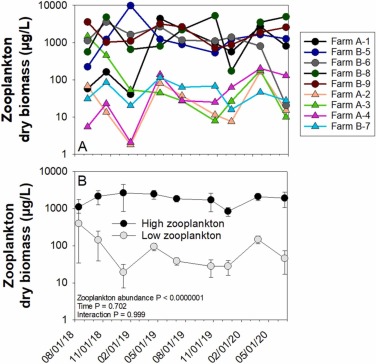
Citation
Belfiore, A., R. P. Buley, E. G. Fernandez-Figueroa, M. Gladfelter, and A. E. Wilson. 2021. Zooplankton as an alternative method for controlling phytoplankton in catfish pond aquaculture. Aquaculture Reports 21:100897.
Abstract
In pond aquaculture, production of toxins and off-flavor compounds by cyanobacteria can negatively affect fish health and production. Studies have explored chemical or physical methods for controlling algal blooms in aquaculture ponds, which although effective, may be short-lived and can negatively impact non-target organisms, including aquaculture species. Food web manipulations have a long history in lake and fisheries management to improve water quality, but have been rarely considered in aquaculture. This study examined zooplankton and phytoplankton communities, cyanobacterial toxins, and nutrients in nine catfish aquaculture farm-ponds in west Alabama, USA. The goal of this project was to track phytoplankton and zooplankton abundances with respect to each other, with and without efforts to reduce zooplanktivorous fish in some of the ponds. During this project, farm managers reduced zooplanktivorous fish abundance in select ponds to create a large-scale field experiment that addressed the role of zooplankton control of phytoplankton in hypereutrophic catfish aquaculture ponds when zooplanktivorous fish were or were not excluded. There was a strong negative effect of zooplankton on phytoplankton, including cyanobacteria, despite high nutrient concentrations. Although high zooplankton ponds sustained elevated zooplankton biomass during much of this study, including when pond temperatures exceeded 30 °C, the effect of zooplankton on phytoplankton was most pronounced during the non-growing season (November–April). In addition, total ammonia nitrogen was significantly higher in high zooplankton ponds, which could lead to ammonia toxicity in fish at elevated temperature and pH. Our findings suggest that zooplankton biomanipulation may be an efficient method to control algal blooms in farm-pond catfish aquaculture.